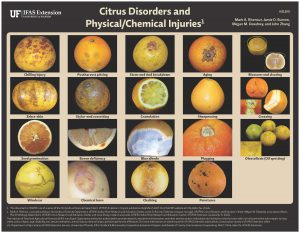
This new one-page Citrus Identification fact sheet illustrates different disorders and injuries that affect citrus. Written by Mark A. Ritenour, Jamie D. Burrow, Megan M. Dewdney, and John Zhang and published by the Horticultural Sciences Department.
http://edis.ifas.ufl.edu/hs1290
Tag: Megan M. Dewdney
Frequently Asked Questions About Huanglongbing (HLB; citrus greening) for Homeowners
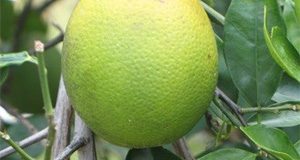
Huanglongbing (HLB), also known as citrus greening, is a serious bacterial disease that affects citrus in Florida. Florida residents enjoy growing citrus for a variety of reasons, but growing citrus in today’s disease climate is not an easy task. This seven-page document is designed to help Master Gardeners and homeowners answer commonly asked questions about HLB. Written by Brooke L. Moffis, Jamie D. Burrow, Megan M. Dewdney, and Michael E. Rogers and published by the Plant Pathology Department.
http://edis.ifas.ufl.edu/pp326
Sintomas de Cancro Citrico en Arboles de Vivero (PP307)
 This is a two-page illustrated identification sheet for citrus canker symptoms that appear in citrus nurseries. Written by Timothy D. Riley, Megan M. Dewdney, and Jamie D. Burrow, and published by the UF Department of Plant Pathology, May 2013.
This is a two-page illustrated identification sheet for citrus canker symptoms that appear in citrus nurseries. Written by Timothy D. Riley, Megan M. Dewdney, and Jamie D. Burrow, and published by the UF Department of Plant Pathology, May 2013.
http://edis.ifas.ufl.edu/pp307
Citrus Canker Symptoms on Nursery Trees (PP304)
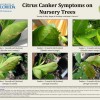 This document is a two-page illustrated identification sheet for citrus canker symptoms that appear in citrus nurseries. Written by Timothy D. Riley, Megan M. Dewdney, and Jamie D. Burrow, and published by the UF Department of Plant Pathology, April 2013.
This document is a two-page illustrated identification sheet for citrus canker symptoms that appear in citrus nurseries. Written by Timothy D. Riley, Megan M. Dewdney, and Jamie D. Burrow, and published by the UF Department of Plant Pathology, April 2013.
http://edis.ifas.ufl.edu/pp304
Informacion para los propietarios: Cancro Citrico (PP298)
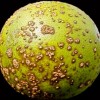 El cancro cítrico es una enfermedad introducida en Florida y es muy perjudicial económicamente para la industria comercial. La enfermedad no está presente en todas las regiones tropicales y subtropicales productoras de cítricos donde el cancro cítrico puede ser problemático, por lo tanto, las restricciones para exportar fruta con cancro cítrico son muy estrictas. Esta enfermedad también concierne a los propietarios, no solo por sus efectos en la industria económica, sino también porque es altamente contagiosa y la mayoría de la fruta contagiada en un árbol muy afectado se cae de éste prematuramente. This 4-page fact sheet was written by M. M. Dewdney, P. D. Roberts, J. H. Graham, K. R. Chung, and M. Zekri, and published by the UF Department of Plant Pathology, January 2013.
El cancro cítrico es una enfermedad introducida en Florida y es muy perjudicial económicamente para la industria comercial. La enfermedad no está presente en todas las regiones tropicales y subtropicales productoras de cítricos donde el cancro cítrico puede ser problemático, por lo tanto, las restricciones para exportar fruta con cancro cítrico son muy estrictas. Esta enfermedad también concierne a los propietarios, no solo por sus efectos en la industria económica, sino también porque es altamente contagiosa y la mayoría de la fruta contagiada en un árbol muy afectado se cae de éste prematuramente. This 4-page fact sheet was written by M. M. Dewdney, P. D. Roberts, J. H. Graham, K. R. Chung, and M. Zekri, and published by the UF Department of Plant Pathology, January 2013.
http://edis.ifas.ufl.edu/pp298
Fungicide Resistance Action Committee's (FRAC) Classification Scheme of Fungicides According to Mode of Action (PI94/PI131)
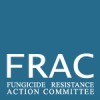 This guide addresses management of pesticide resistance and describes the Fungicide Resistance Action Committee’s (FRAC) classification of fungicides and bactericides registered for agricultural and non-agricultural use in Florida by their modes of action. A cross-reference of common names for active ingredients, along with corresponding examples of their trade names, is also provided. Written by F.M. Fishel and M.M. Dewdney, and published by the UF Department of Agronomy, November 2012.
This guide addresses management of pesticide resistance and describes the Fungicide Resistance Action Committee’s (FRAC) classification of fungicides and bactericides registered for agricultural and non-agricultural use in Florida by their modes of action. A cross-reference of common names for active ingredients, along with corresponding examples of their trade names, is also provided. Written by F.M. Fishel and M.M. Dewdney, and published by the UF Department of Agronomy, November 2012.
http://edis.ifas.ufl.edu/pi131
Identificacion de los sintomas del cancro citrico y procedimientos de descontaminacion (PP214SP/PP138)
 El cancro cítrico es una seria enfermedad de los cítricos. La mayoría de los cultivos de cítricos son susceptibles, la toronja, la lima mejicana y algunas naranjas tempranas son las más susceptibles. Una infección severa puede causar defoliación, una muerte regresiva de la rama, una decadencia general del árbol, una caída prematura de la fruta, y manchas en la misma. Los árboles severamente infectados se vuelven débiles, improductivos y no rentables. This 5-page fact sheet was written by Mongi Zekri, Megan Dewdney, Jamie Burrow, and Pamela Roberts, and published by the UF Department of Plant Pathology, August 2012.
El cancro cítrico es una seria enfermedad de los cítricos. La mayoría de los cultivos de cítricos son susceptibles, la toronja, la lima mejicana y algunas naranjas tempranas son las más susceptibles. Una infección severa puede causar defoliación, una muerte regresiva de la rama, una decadencia general del árbol, una caída prematura de la fruta, y manchas en la misma. Los árboles severamente infectados se vuelven débiles, improductivos y no rentables. This 5-page fact sheet was written by Mongi Zekri, Megan Dewdney, Jamie Burrow, and Pamela Roberts, and published by the UF Department of Plant Pathology, August 2012.
http://edis.ifas.ufl.edu/pp138
Mancha negra de los citricos (PP295)

Este documento es una hoja de dos páginas ilustrativas para la identificación de la mancha negra de los cítricos. This 2-page fact sheet was written by Megan M. Dewdney and Natalia A. Peres, and published by the UF Department of Plant Pathology, August 2012. http://edis.ifas.ufl.edu/pp295
Enfermedades Exoticos de los Citricos (PP296)
 Este documento es una hoja de dos páginas ilustrativas para la identificación de las enfermedades exóticas de los cítricos. This 2-page fact sheet was written by M. M. Dewdney, J. D. Burrow, M.E. Rogers, and T. M. Spann, and published by the UF Department of Plant Pathology, August 2012.
Este documento es una hoja de dos páginas ilustrativas para la identificación de las enfermedades exóticas de los cítricos. This 2-page fact sheet was written by M. M. Dewdney, J. D. Burrow, M.E. Rogers, and T. M. Spann, and published by the UF Department of Plant Pathology, August 2012.
http://edis.ifas.ufl.edu/pp296
Enfermedades fungicas foliares de los citricos para los patios y zonas residenciales (PP297)
 Este documento es una hoja de dos páginas ilustrativas para la identificación de las enfermedades fúngicas foliares de los cítricos. This 2-page fact sheet was written by M. M. Dewdney and J. D. Burrow, and published by the UF Department of Plant Pathology, August 2012.
Este documento es una hoja de dos páginas ilustrativas para la identificación de las enfermedades fúngicas foliares de los cítricos. This 2-page fact sheet was written by M. M. Dewdney and J. D. Burrow, and published by the UF Department of Plant Pathology, August 2012.
http://edis.ifas.ufl.edu/pp297
A Web-Based Tool for Timing Copper Applications in Florida Citrus (PP289)
 The Citrus Copper Application Scheduler provides citrus growers with an easy-to-use tool to guide copper application decisions. It is an updated version of a previous copper residue model This 4-page fact sheet was written by Megan M. Dewdney, Clyde W. Fraisse, Tiago Zortea, and Jamie Burrow, and published by the UF Department of Plant Pathology, January 2012.
The Citrus Copper Application Scheduler provides citrus growers with an easy-to-use tool to guide copper application decisions. It is an updated version of a previous copper residue model This 4-page fact sheet was written by Megan M. Dewdney, Clyde W. Fraisse, Tiago Zortea, and Jamie Burrow, and published by the UF Department of Plant Pathology, January 2012.
http://edis.ifas.ufl.edu/pp289
Field Identification of Citrus Canker Symptoms and Decontamination Procedures (PP214/PP136)

Citrus canker, caused by the bacterial pathogen Xanthomonas citri subsp. citri, is a serious disease of citrus. The disease causes necrotic dieback, general tree decline, premature fruit drop, and fruit blemishes. Severely infected trees become weak, unproductive, and unprofitable. Learn how to identify citrus canker and proper procedures for decontamination with this 5-page fact sheet written by Mongi Zekri, Megan Dewdney, Jamie Yates, and Pamela Roberts, and published by the UF Department of Plant Pathology, July 2011.
http://edis.ifas.ufl.edu/pp136
Identification of Early Citrus Black Spot Symptoms (Identificacíon de los Síntomas Iniciales de la Mancha Negra de los Cítricos) (PP285)
 This bilingual identification sheet was designed to assist packinghouse employees to identify the early yet subtle symptoms of citrus black spot. Proper identification of citrus black spot prevents the rejection of international fruit shipments. Written by M. M. Dewdney, J. D. Yates, and M. A. Ritenour and published by the UF Department of Plant Pathology, July 2011.
This bilingual identification sheet was designed to assist packinghouse employees to identify the early yet subtle symptoms of citrus black spot. Proper identification of citrus black spot prevents the rejection of international fruit shipments. Written by M. M. Dewdney, J. D. Yates, and M. A. Ritenour and published by the UF Department of Plant Pathology, July 2011.
http://edis.ifas.ufl.edu/pp285
Quick Reference Guide to Foliar Fungicides (PP275)
This revised 2-page reference guide provides quick access to foliar fungicide recommendations from the Florida Citrus Pest Management Guide. Verso provides guidelines for fungicide resistance management. Written by M. M. Dewdney and published by the UF Department of Plant Pathology, April 2011.
http://edis.ifas.ufl.edu/pp275
Postharvest Decay Control Recommendations for Florida Citrus Fruit (CIR359A/CH081)
Decay of citrus fruit is most often caused by fungal pathogens that grow and develop in the hot and wet conditions typical of the Florida climate. Losses from these diseases can be reduced by the practices discussed in this 6-page revised fact sheet written by Mark A. Ritenour, Jiuxu Zhang, and Megan Dewdney, and published by the UF Department of Horticultural Sciences, February 2011.
http://edis.ifas.ufl.edu/ch081
Citrus Black Spot: No Longer an Exotic Disease (PP281)
Citrus black spot is an emerging fungal disease that affects Florida citrus. Various symptom types occur about a month before harvest. Black spot has the potential to cause major economic damage to the fresh fruit industry and significant yield loss on processing varieties. This trifold brochure was written by Megan Dewdney and Jamie Yates, and published by the UF Department of Plant Pathology, January 2011.
http://edis.ifas.ufl.edu/pp281
Exotic Citrus Diseases: Early Detection is the Solution to Protecting Florida Citrus (CH202)
This revised illustrated trifold brochure provides key information about Pseudocercospora fruit and leaf spot, sweet orange scab, citrus leprosis virus, citrus variegated chlorosis (CVC), and citrus tristeza virus (CTV) stem pitting. Includes contact information for UF/IFAS Extension citrus experts. Written by R. H. Brlansky, M. M. Dewdney, and J. D. Yates, and published by the UF Department of Plant Pathology, June 2010.
http://edis.ifas.ufl.edu/ch202
PP279/CG088 2011 Florida Citrus Pest Management Guide: Citrus Black Spot
PP279, a 6-page fact sheet by Megan M. Dewdney, Timothy S. Schubert, Mark R. Estes, and Natalia Peres, provides citrus producers with essential information for management of this fungal disease that causes fruit blemishes and significant yield losses — regulatory considerations and recommended chemical controls. Published by the UF Department of Plant Pathology, December 2010.
http://edis.ifas.ufl.edu/cg088
HS1184 Packinghouse Citrus Black Spot ID / Identificación de la Mancha Negrade los Cítricos en las Plantas de Procesamiento
HS1184, a one-page identification sheet in English and Spanish by Mark Ritenour, Megan Dewdney, Natalia Peres, and Jamie Yates, assists packinghouse graders in the detection of citrus black spot. Published by the UF Department of Horticultural Sciences, August 2010.
http://edis.ifas.ufl.edu/hs1184
PP277 Citrus Black Spot Management Timing Schedule
PP277, a 2-page illustrated handout by Megan M. Dewdney and Jamie D. Yates, provides a condensed version of citrus black spot management recommendations and application timings for various citrus fungal diseases. Published by the UF Department of Plant Pathology, July 2010.
http://edis.ifas.ufl.edu/pp277